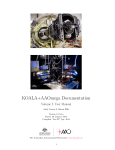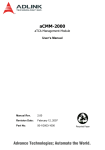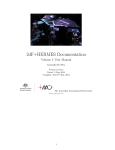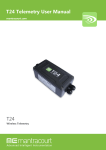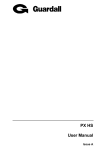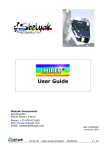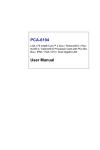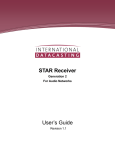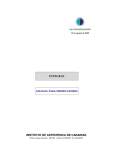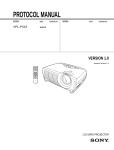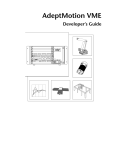Download 2dfdr Maintenance Guide - AAO - Anglo
Transcript
ANGLO-AUSTRALIAN OBSERVATORY
AAO Software Report 107
2dfdr Maintenance Guide
Jeremy Bailey, Tony Farrell, Ron Heald
25 August 2005
2dfdr Maintenance Guide
Contents
1
2DFDR OVERVIEW ................................................................................................................... 3
1.1
2
GLOSSARY ........................................................................................................................... 3
BUILDING 2DFDR ..................................................................................................................... 4
2.1
2.2
2.3
2.4
2.5
2.5.1
2.5.2
2.6
2.6.1
2.6.2
2.7
2.7.1
2.7.2
2.7.3
2.8
2.8.1
2.8.2
2.9
2.10
PREREQUISITES................................................................................................................... 4
2DFDR BASIC BUILD PROCEDURE ..................................................................................... 4
PARTIAL BUILDS................................................................................................................. 5
THE SUBSYSTEMS .............................................................................................................. 5
FUTURE CHANGES TO BUILD SYSTEM .............................................................................. 7
2dfdr ................................................................................................................................ 7
DRAMA............................................................................................................................ 7
ACCM .................................................................................................................................. 7
Setting Up for ACMM ...................................................................................................... 7
Using ACMM ................................................................................................................... 8
MODIFYING 2DFDR ............................................................................................................. 8
Modifying the Archive...................................................................................................... 8
Branching ........................................................................................................................ 8
Modifying the Readonly Version ..................................................................................... 8
BUILD CONFIGURATION .................................................................................................... 8
Setting Compiler Options ................................................................................................ 9
System Version Capture................................................................................................... 9
VERSION NUMBER AND DATE .......................................................................................... 9
RUNNING 2DFDR AFTER A BUILD ..................................................................................... 9
3
TESTING 2DFDR...................................................................................................................... 11
4
THE DRAMA TASKS DRCONTROL AND DREXEC......................................................... 12
4.1
INTRODUCTION ................................................................................................................. 12
4.2
DRCONTROL ...................................................................................................................... 12
4.3
DREXEC ............................................................................................................................. 12
4.3.1
The EXECUTE action.................................................................................................... 12
4.3.2
The FILES component ................................................................................................... 13
4.3.3
The SEQUENCE component ......................................................................................... 13
4.3.4
Examples of EXECUTE argument structure.................................................................. 14
5
THE CLALIB AND TDFRED CLASS LIBRARIES.............................................................. 17
5.1
5.2
5.3
5.4
5.5
SUMMARY ......................................................................................................................... 17
GETTING STARTED ........................................................................................................... 17
CLASSES AND METHODS ................................................................................................. 20
ARITHMETIC OPERATIONS .............................................................................................. 21
USING THE CLASS LIBRARY IN ADAM APPLICATIONS ................................................ 22
Page 1 of 42
5.6
5.7
GENERIC OPERATIONS ..................................................................................................... 23
GROUPS OF OBJECTS ........................................................................................................ 24
A
Starlink Routine Modifications.......................................................................................... 26
A.1 The x.c File................................................................................................................... 26
A.2 The err.f file.................................................................................................................. 26
B
The 2dfdr release................................................................................................................ 26
B.1 2dfdr specific files ........................................................................................................ 26
B.2 Other files..................................................................................................................... 27
B.3 DRAMA Files .............................................................................................................. 27
B.4 Starlink files ................................................................................................................. 28
B.5 Tcl/Tk/tix files .............................................................................................................. 28
B.6 WCS files. .................................................................................................................... 28
C
Clalib Classes and Methods ............................................................................................... 30
C.1 Class NDF .................................................................................................................... 30
C.2 Class 1D ....................................................................................................................... 31
C.3 Class 2D ....................................................................................................................... 31
C.4 Class GROUP............................................................................................................... 31
C.5 Other Classes................................................................................................................ 32
D
Tdfred Classes and Methods .............................................................................................. 33
D.1 Class BIAS ................................................................................................................... 33
D.2 Class BIASCG.............................................................................................................. 33
D.3 Class BIASGRP ........................................................................................................... 33
D.4 Class BIASRED ........................................................................................................... 33
D.5 Class CALGRP ............................................................................................................ 34
D.6 Class CCDIMAGE ....................................................................................................... 34
D.7 Class DARK................................................................................................................. 34
D.8 Class DARKCG ........................................................................................................... 34
D.9 Class DARKGRP ......................................................................................................... 35
D.10 Class DARKRED ....................................................................................................... 35
D.11 Class FFLATCG......................................................................................................... 35
D.12 Class LFLAT.............................................................................................................. 35
D.13 Class LFLATCG ........................................................................................................ 36
D.14 Class LFLATGRP ...................................................................................................... 36
D.15 Class LFLATRED ...................................................................................................... 36
D.16 Class MFARC ............................................................................................................ 36
D.17 Class MFFFF.............................................................................................................. 37
D.18 Class MFFLX............................................................................................................. 37
D.19 Class MFIMAGE ....................................................................................................... 37
D.20 Class MFOBJECT...................................................................................................... 38
D.21 Class MFSARC.......................................................................................................... 38
D.22 Class MFSFFF ........................................................................................................... 38
D.23 Class MFSFLX .......................................................................................................... 39
D.24 Class MFSGRP .......................................................................................................... 39
D.25 Class MFSKY ............................................................................................................ 39
D.26 Class MFSOBJECT.................................................................................................... 39
D.27 Class MFSPEC........................................................................................................... 39
D.28 Class MFSPIRAL....................................................................................................... 40
D.29 Class MFSSKY .......................................................................................................... 40
D.30 Class MFSSPIRAL .................................................................................................... 40
D.31 Class THPTCG........................................................................................................... 41
D.32 Class TLMAP............................................................................................................. 41
D.33 Class TMCG............................................................................................................... 41
D.34 Class WAVECG......................................................................................................... 41
Revisions:
01-Jul-2003:
03-Jul-2003:
26-Feb-2004:
02-Mar-2004:
17-May-2004:
28-Jan-2004:
TJF. Converted original document 2nd June version from Latex to MS Word. Previously did not have
an ASD number or version number. When changes were complete, this became ACMM version 1.3.
TJF. Modified to describe use of acmmSystemBuild to do build.
RWH Bring up to current development, Fix typos.
RWH Another iteration.
RWH Improve Execution Task section.
RWH More work on drcontrol and drexec sections.
1 2dfdr Overview
2dfdr is the AAO’s data reduction software for fibre feed Multi-Object spectrographs.
It was originally written for the 2dF instrument, but has been modified to support
other similar instruments including 6dF, Spiral, and LDSS. It is currently being
modified to support the new AAOmega instrument.
2dfdr uses several languages and tools to accomplish its function. It uses the compiled
languages Fortran, C, and C++, and the Tcl scripting language. To provide the GUI, it
uses the Tk graphical interface development tool, and the Tix set of user interface
components that are built on Tk. It also uses AAO’s DRAMA distributed information
system (middleware) for communication between tasks, and the Starlink CNF and
F77 Mixed Language Programming – Fortran and C package.
1.1
Glossary
Term
Description
ACMM
AAO’s source code management system
DRAMA
AAO’s distributed real-time application programming
environment (middleware) used by 2dfdr to support
multitasking communications in portable way
FITS
Flexible Image Transport System data file format
GNS
???
GSN
???
GUI
Graphical User Interface
HDS
Starlink’s Hierarchical Data System
NDF
Starlink’s Extensible N-Dimensional data file Format
SDS
AAO’s Self defining Data Structures
Starlink
The organization charged with supporting the computing
needs of the U.K. Astronomy community. Also used to refer
to the suite of software released by Starlink.
Tcl
Tool Command Language, a scripting language
Tk
Tcl’s windowing toolkit used to build GUI’s
Tix
An extended set of GUI widgets for Tk
Page 3 of 42
2 Building 2dfdr
2dfdr is stored in and built using the AAO’s source code management system –
known as ACMM. 1.
2.1
Prerequisites
The following prerequisites are required to build ACMM.
•
A machine with a supported architecture, currently Solaris 8 and 9, and Linux
RedHat 7.3 and 9 (normally the architectures supported by Starlink).
•
Sufficient disk space (~350 MB)
•
C, C++ and Fortran compilers.
•
A recent version of DRAMA with some changes to the DramaConfig subsystem (ACMM version 3.9 of the DramaConfig sub-system). This is
presumed to be available in directory ~drama (if it is elsewhere, then replace
~drama by the directory containing DRAMA).
•
A recent version of Starlink (Spring 2003, aka Summer 2003, was used as of
this writing) in /star. 2dfdr uses a number of Starlink subroutine libraries. To
build 2dfdr the Starlink software collection must be installed and must be
accessible via a link to /star. The Starlink software is available on CD from
Starlink (see http://www.starlink.rl.ac.uk).
•
Access to ACMM. See section 2.6
2.2
2dfdr basic build procedure
This depends a little on the architecture you are using; through we hope to change this
in the future.
On Solaris
~drama/dramastart2
acmmSystemBuild 2dfdr
On Linux
~drama/dramastart2
acmmSystemBuild 2dfdr
1
last –L/usr/X11R6/lib3
ACMM is based on the ESO CMM software, used with permission by the AAO.
2
There may be an appropriate version specification required. At AAO Epping as of
December 2004, you need to add “-v 14dec04_linux” to the command.
4 of 42
The result of these commands is the fetching of all the software from ACMM into
subdirectories, the building of the software and creation of two extra sub-directories.
The first of these is named “release”, and contains the full set of files (libraries etc)
created by the build. It is the install directory for the various sub-systems being built.
The second extra sub-directory is named 2dfdr-{arch}, where {arch} will be
either “sun4_solaris” or “linux_x86” indicating the build target architecture.
This directory contains an independent release directory. It can be tar’ed up and
moved at will (although there may be some restrictions on operating system versions
due to sharable library version issues). At run time, the environment variable
DRCONTROL_DIR should be defined to this directory. (Note the location should be
such that the value of DRCONTROL_DIR is less then 40 characters, due to an
apparent bug in Starlink).
A log of the build is written to the “install.log” file. You can examine the contents of
this file to help determine build problems. It is often useful to open another terminal
window and use “tail –f install.log” during the build process.
2.3
Partial Builds
As above, but you may want to add the following flags before “2dfdr.”
Flag
Description
-start {subsystem}
Start building from the specified sub-system (as
mentioned below).
-stop {subsystem}
Stop building after the specified sub-system is built.
Note this prevents the post build hook (used to
create the release directory) from being built.
-nofetch
Don’t check if the source directories are up to date
with those in the source archive.
2.4
The Subsystems
The following table lists the sub-systems fetched from ACMM and used in the 2dfdr
build. The sub-system name indicates the ACMM name and the sub-directory in
which the software will be placed. The order in the table is the build order.
3
The requirement for “last –L/usr/X11R6/lib” is to work around a problem in the
DRAMA configuration files. It is needed to correctly locate the X11 libraries. A
future revision to the DRAMA configuration files will avoid this issue. Note that the
current
(Jul
03)
location
of
Linux
DRAMA
is
/instsoft/dramasrc/linux/drama-v1.4.2/, which must replace
~drama in this line. Also note that “last” is the normal default and is only needed
here to allow the following argument.
5 of 42
Subsystem
Description
2dfdr*
Contains
the
2dfdr
description
used
by
the
acmmSystemBuild and acmmSystemFetch commands.
The file 2dfdr.cfg contains this information.
Tcl
The Tool Command Language. The version must match that
used by Starlink – which can be determined by running
/star/bin/wish* and executing the command “info tclversion”.
Tk
Tcl’s Windowing toolkit. Details as per Tcl. From Version 8.0
of Tcl and Tk use the same version numbers. Prior to this, the
version numbers are different. 2dfdr as supported by
acmmSystemBuild does not work with versions of Tcl/Tk prior
to version 8.0.
Tix
A Tck/Tk widget set used by 2dfdr. The version of Tix used
must support the version of Tcl used. Note that the “THEVER”
specification in 2dfdr.cfg must specify the version of Tcl/Tk to
be used.
wcstools
World Coordinate system tools. A set of FITS header tools.
Only the gethead and sethead programs are needed.
sds
The DRAMA Self Defining Data system. This must be rebuilt
against the version of the Tcl/Tk being used. (Also, the exact
version of the C++ compiler and Fortran compiler).
DramaDul
The DRAMA Utilities Library (DUL). This must be rebuilt
against the version of the Tcl/Tk being used. (Also, the exact
version of the C++ compiler and Fortran compiler).
DramaTcl
The DRAMA Tcl Interface (DTCL). This must be rebuilt
against the version of the Tcl/Tk being used.
aaoDramaTclUtil
A set of AAO DRAMA Tcl scripts.
clalib*
AAO data reduction Fortran “class” library.
nswc
The (public domain) Naval Surface Warfare Center library of
mathematical routines.
tdfred*
2dF data reduction Fortran “class” library.
drexec*
The 2dfdr data reduction execution task.
drcontrol*
The 2dfdr data reduction control program. This also contains
the release script and run time start up scripts.
ASD107*
Contains this document and the 2dfdr User Manual. Nothing is
actually built in this sub-system.
6 of 42
Sub-systems marked with * are the components of 2dfdr itself. The remaining subsystems are dependencies.
2.5
Future changes to build system
This section notes intended future changes to the release and build procedure.
2.5.1 2dfdr
The build procedure needs to check the Tcl and Tk versions used are compatible with
those used by Starlink. This can be done in the post fetch or pre build hooks.
A way is needed to extract the acmmSystem files to allow a build without having
access to the ACMM library.
A way is needed to extract the definitions needed to build the individual components
(the post build hook could extract the environment variable values into a file).
2.5.2 DRAMA
DRAMA must be changed such that instead of having to override the values of the
SYSTARGET, SYSHOST and SYSRELEASE, only one value needs to be
overridden.
The DRAMA configuration files must be changed such that we can specify the
location of Tcl/Tk independently of specifying the locations of X11 and other things
required to link Tcl/Tk.
2.6
ACCM
2.6.1 Setting Up for ACMM
ACMM is the AAO source code archiving system. In order to use ACMM certain
files and environment variables must be set appropriately. If the command
“acmmWho” returns an error indicating an unknown command, then the setup is not
correct. To do so, execute the setup line from the following table according to your
location and shell. This line can be added to your shell start up script so that ACMM
commands are always available.
Location
Shell
ACMM Set up Line
Epping Solaris
sh/zsh/bash/ksh
. /local/soft/solaris/acmmlib/acmm_setup.sh
Epping Solaris
Csh/tcsh
source /local/soft/solaris/acmmlib/acmm_setup.csh
Epping Linux
zsh/bash/ksh
. /local/soft/linux/acmmlib/acmm_setup.sh
Epping Linux
Csh/tcsh
source /local/soft/solaris/acmmlib/acmm_setup.csh
Coona Solaris
sh/zsh/bash/ksh
. /instsoft/acmm/acmmlib/acmm_setup.sh
Coon Solaris
Csh/tcsh
source /instsoft/acmm/acmmlib/acmm_setup.csh
7 of 42
If “acmmWho” indicates that a file named “.acmmrc” can’t be opened for reading,
then you need to arrange access to ACMM. Please send an e-mail to
[email protected].
2.6.2 Using ACMM
Sufficient knowledge to build 2dfdr has now been provided. If you need to modify the
2dfdr archived source code, then you must become familiar with the basic operation
of ACMM. This is described in AAO Software Document 101. Type “acmmCopy
ASD101” to fetch this document. This will create a local directory containing this
document. It also contains a PowerPoint presentation on ACMM. Note that the basic
operations require only 4 commands (acmmCopy, acmmModify, acmmArchive, and
acmmCheckForArchive) in addition to acmmSystemBuild.
2.7
Modifying 2dfdr
There are three ways of modifying 2dfdr. Note that it is expected that most people
modifying 2dfdr will only need to change tdfred, drcontrol, drexec, and just possibly
clalib.
2.7.1 Modifying the Archive
This should only be done with the intention of introducing changes into the main
code. It should be done using the appropriate ACMM commands by an authorized
maintainer. See the ACMM document (ASD101) for details.
2.7.2 Branching
It may be appropriate to branch 2dfdr for experiential work or to provide bug fixes.
ACMM supports branching but it is intended that braches either die or are quickly
merged back into the main-line code. See the ACMM document (ASD101) for
details.
2.7.3 Modifying the Readonly Version
This is a dangerous technique due to the chance of the changes getting lost. In a
normal build, all the source files are marked “readonly”. You can change this using
“chmod u+w {file}” and then make changes to the file. This may be appropriate for
experimental changes by someone without access to ACMM, but they must keep
careful track of the changes and ensure that if they are intended for the main-line
code, they get into the ACMM version at some point.
2.8
Build Configuration
The order of the build and options to the build are set in the 2dfdr subsystem, file
2dfdr.cfg. This obeys the rules laid down by acmmSystemFetch and
acmmSystemCapture. The best source for information about this scheme is the
PowerPoint presentation in the ASD101 ACMM module.
8 of 42
2.8.1 Setting Compiler Options
When modifying the 2dfdr.cfg file or running dmkmf independently (not yet practical)
you should set compiler options (e.g. Optimize level or debug) by running dmkmf
with a -O or -g argument. The -O option should normally be used with the nswc,
clalib and tdfred libraries to get good execution speed. With the other sub
systems it is not critical.
2.8.2 System Version Capture
The ACMM build configuration file (2dfdr.cfg) allows the ACMM version of each
sub-system to be specified. When specified as “last” the last available version is used,
but it is often appropriate to specific particular versions for all sub-system so that you
can return to a known configuration.
ACMM supports the idea of capturing the current version of each sub-system into the
system configuration file (2dfdr.cfg). This is done with the acmmSytemCapture
command. But this is not necessarily appropriate for Tcl/Tk/Tix. Here you must
specify the version appropriate for the version of Starlink to be used. So if you used
acmmSystemCapture, you must unwind any change to the specifications for
Tcl/Tk/Tix.
acmmSystemCapture may mess up the Tcl/Tk/Tix version
specification.
You must hand-edit 2dfdr.cfg after running acmmSystemCapture
to check and if necessary fix this.
2.9
Version Number and Date
The 2dfdr version number and date (which appears in the title bar of the user
interface) are set in the drcontrol and drexec tasks. The following lines (or something
similar) will be found in the drcontrol.C and drexec.c files:
extern char* DrcontrolVersion;
extern char* DrcontrolDate;
Compiling the files drcontrolversion.c and drexecversion.c sets these variables. This
is done in such a way to force the file to be recompiled if the version number changes.
The version number is based on the ACMM version number and is therefore updated
automatically when the subsystems are updated.
2.10 Running 2dfdr after a build
To run the 2dfdr version you have just built, do the following:
setenv DRCONTROL_DIR {build-directory}
source $DRCONTROL_DIR/2dfdr_setup
9 of 42
where build-directory is, for example, /home/rwh/2dfdr/2dfdr-linux_x86
or /home/rwh/2dfdr/2dfdr-sun4_solaris. The command "drcontrol"
should now start up 2dfdr.
Due to a problem in the Starlink libraries used by 2dfdr, the
value for DRCONTROL_DIR must not exceed 40 characters.
Getting this wrong will cause the plotting facilities to fail.
10 of 42
3 Testing 2dfdr
There is a 2dF sample data set available which can be used to test the basic
functionality of 2dfdr. It can be found at
ftp://ftp.aao.gov.au/pub/2df/sample_data.tar.Z
It contains the following files:
11may0001.sdf
11may0002.sdf
11may0003.sdf
11may0004.sdf
11may0005.sdf
README
To run 2dfdr on this dataset untar the data, cd to the directory containing the data and
type the following.
drcontrol&
The 2dfdr user interface and two plot windows should then appear. Click the SkySub
tab on the left section of the screen and select “Throughput Calibration Method SKYFLUX(COR)”.
In the automatic reduction section on the top right of the user interface, click the
Setup button, and select OK in the dialog box which appears. 2dfdr should then show
5 files in the automatic reduction box.
Click the Start button in the automatic reduction section and it will reduce the data
going through the five files in turn using the default TRAM method.
To repeat the reduction exit from 2dfdr and type:
rm *red.sdf *tlm.sdf
And start drcontrol again. This time select the Extract tab, select Method: FIT and
turn on "Subtract Scattered Light". Click the SkySub tab and select “Throughput
Calibration Method - SKYFLUX(COR)”.
Click Setup and Start as before. The reduction proceeds as before but take a lot
longer in this mode
11 of 42
4 The DRAMA Tasks drcontrol and drexec
4.1
Introduction
The 2dF data reduction system makes use of two DRAMA tasks, the user interface
task (drcontrol) and the execution task (drexec). The drcontrol task does its work by
requesting DRAMA actions from one or more execution tasks.
The drcontrol main program is written in C++. drcontrol also makes extensive use of
Tcl/Tk and the Tix widget set to provide a GUI.
The drexec main program is written in the C language, while the actual data reduction
algorithms are written in Fortran in the form of a class library (see Sections 5 and 6).
The drexec task is linked with the class library and calls the Fortran routines by
making use of the Starlink CNF/F77 C language to Fortran language package
(described in SUN/209). In essence drexec provides a DRAMA interface to the
Fortran class library interface described in the clalib and tdfred sections.
4.2
drcontrol
The drcontrol task “unit of work” is the reduction of a single file. A work unit is
passed by the drcontrol task to the drexec task in the form of a single EXECUTE
action. The drexec task opens all files needed in the course of the reduction and closes
all files when it is complete.
Notice drcontrol handles both NDF and FITS format files, converting FITS to NDF
format before passing them to drexec. Only NDF format files are seen by drexec.
4.3
drexec
4.3.1 The EXECUTE action
The drexec task does most of its work in response to a DRAMA action with the name
EXECUTE. The EXECUTE action specifies, in its argument structure, the data
reduction operation to be performed. The operation can range from execution of a
single step to an arbitrarily complex sequence of steps.
Operations using the class library methods require specification of the object to be
operated on, the method to be invoked, and the arguments to be supplied to the
method (in the form of a SDS arguments structure). The class library operates on
objects specified by means of their NDF identifiers (described in SUN/33). Since
NDF identifiers are only meaningful within the context of a single process, the
EXECUTE action has to be told how to derive these identifiers from container files.
This information is provided by means of the FILES section in the EXECUTE action
argument structure. The sequence of methods to be executed is specified in the
SEQUENCE section of the structure.
12 of 42
4.3.2 The FILES component
The FILES component of the argument structure links parameter names with file
names and specifies how an NDF identifier is to be obtained from the file. It is an
SDS structure with the following components:
DIRECTORY
The DIRECTORY component is a character string
specifying the directory for all files. The drexec task sets its
default to this directory before accessing any files. Thus all
files will be taken from this directory.
Parameter Entries
Subsequent components in this structure are parameter
entries with the structure component name being the SDS
parameter name. The drcontrol task normally creates
parameter entries with names of the form P0, P1, P2 etc.
allocated sequentially. However, any valid SDS name will
be accepted by drexec as a parameter name.
Each parameter entry is itself a structure and must have a NAME component
specifying the name of the file (with any extension) to be used, and an ACCESS
component specifying how an NDF identifier is to be obtained from the filename.
ACCESS must be one of the following strings:
READ
The file will be opened for READ access, by using the
READ method of the NDF class.
UPDATE
The file will be opened for UPDATE access, by using the
UPDATE method of the NDF class.
TEMPLATE
A new file will be created based on a “template” file, using
the template method of the NDF class. The new file
contains everything in the template file except for the
DATA, QUALITY, and VARIANCE components. An
additional argument, TEMPLATE, is required with this
access to specify the template file. This should be a
parameter reference beginning with a $ as described below.
Two
optional
arguments,
ADD_SUFFIX
and
REMOVE_SUFFIX, can also be specified.
NEW
A new identifier will be created by the method to be
invoked in the sequence section. No identifier need exist
before invoking the method.
Notice all files are closed when the EXECUTE action completes.
4.3.3 The SEQUENCE component
The SEQUENCE component is a one dimensional structure array with one
component for each step in the sequence of operations to be executed. Each step
results in the invocation of one method in the class library. The structure for each step
contains the following components:
13 of 42
OBJECT
The object is specified as a character string containing the
parameter entry name of the object to be operated on
prefixed by a $ character. The same name must be present
in the FILES component.
METHOD
The name of the method to be invoked.
CLASS
The name of the class for which the method should be
invoked. This is optional and normally unnecessary. When
CLASS is not specified the method will be invoked by
using the generic class routine CLA_GENER which will
determine the appropriate class by looking at the object
itself. Specifying the class explicitly will override this
choice. Currently the CLASS item is only suported for the
GROUP class.
ARGS
The arguments to be passed to the class. This is identical to
the arguments structure which would be passed to the class
library routines, except for arguments which are NDF
identifiers. These are specified via parameters, using a
character string with a $ character preceding the parameter
entry name. The parameter name is replaced by the
corresponding NDF identifier before the arguments
structure is passed to the class routine.
4.3.4 Examples of EXECUTE argument structure
This example structure executes the PLOT method on the
/data4/jab/tests/im256.sdf to generate a false colour plot on device `xwindows'
.
Arguments
Struct
FILES
Struct
DIRECTORY
Char
P0
Struct
[17] "/data4/jab/tests"
NAME
Char
[10] "im256.sdf"
ACCESS
Char
[5] "READ"
SEQUENCE
Struct
SEQUENCE[1]
[1]
Struct
OBJECT
Char
[4] "$P0"
METHOD
Char
[5] "PLOT"
ARGS
Struct
DEVICE
Char
[9] "xwindows"
INTERACTIVE
Int
1
PLOTTYPE
Char
[7] "COLOUR"
14 of 42
file
The following example constructs a group object containing five files.
Arguments
Struct
FILES
Struct
DIRECTORY
Char
P0
Struct
[17] "/data4/jab/tests"
NAME
Char
[12] "test_group"
ACCESS
Char
[4]
P1
"NEW"
Struct
NAME
Char
[7] "r2.sdf"
ACCESS
Char
[5] "READ"
P2
Struct
NAME
Char
[7] "r3.sdf"
ACCESS
Char
[5] "READ"
P3
Struct
NAME
Char
[7] "r4.sdf"
ACCESS
Char
[5] "READ"
P4
Struct
NAME
Char
[7] "r5.sdf"
ACCESS
Char
[5] "READ"
P5
Struct
NAME
Char
[7] "r6.sdf"
ACCESS
Char
[5] "READ"
SEQUENCE
Struct
SEQUENCE[1]
[1]
Struct
METHOD
Char
[11] "MAKE_GROUP"
OBJECT
Char
[4] "$P0"
CLASS
Char
[6] "GROUP"
ARGS
Struct
FILENAME
Char
[12] "test_group"
PERMANENT
Int
1
NOBJECTS
Int
5
OBJECT1
Char
[4] "$P1"
OBJECT2
Char
[4] "$P2"
OBJECT3
Char
[4] "$P3"
OBJECT4
Char
[4] "$P4"
OBJECT5
Char
[4] "$P5"
15 of 42
The following example adds the constant 0.1 to the file im1024.sdf to give the output
file junk.sdf.
Arguments
Struct
FILES
Struct
DIRECTORY
Char
P1
Struct
NAME
ACCESS
P0
[17] "/data4/jab/tests"
Char
[11] "im1024.sdf"
Char
[5] "READ"
Struct
NAME
Char
[5] "junk"
ACCESS
Char
[9] "TEMPLATE"
TEMPLATE
Char
[4] "$P1"
SEQUENCE
Struct [1]
SEQUENCE[1]
Struct
METHOD
Char
[13] "CARITHMETIC3"
OBJECT
Char
[4] "$P0"
ARGS
Struct
OBJECT1
Char
[4] "$P1"
CONSTANT
Float
0.1
OPERATION
Char
[2] "+"
16 of 42
5 The Clalib and Tdfred Class Libraries
5.1
Summary
The data reduction class libraries consist of many Fortran subroutines that provide
facilities for writing data reduction software. The subroutines operate on Starlink
standard NDF data structures. The subroutines do not depend on any particular
software environment and can be used in standalone Fortran programs, though they
can also be used effectively within the ADAM environment. The library is written in
portable Fortran 77 and currently exists in versions for SUN/Solaris and Linux
architectures.
The tdfred library is meant to provide functions specific to 2dfdr, while the clalib
functions provide data reduction functions for more general use. In addition to 2dfdr,
the clalib library is used by the “aaoplot” application maintained by Jeremy Bailey.
The organisation of the libraries attempts to use object-oriented programming
methodology, and this is why they are referred to as “class” libraries. It is not
necessary to have any familiarity with object-oriented programming in order to make
use of the libraries.
A disadvantage to this organisation is linking is effectively done at execution time.
This means a missing function will not be noticed until an attempt to call it is made. It
also means that the usefulness of linking libraries is lost because all functions are
loaded whether they are used or not.
This document is an introductory guide for programmers, which explains how to use
the clalib and tdfred libraries to write useful programs.
5.2
Getting Started
We start by presenting a simple example of a program using the clalib class library.
The example is an interactive image display program, which displays an image on a
display device, and then puts up a cursor and enables a variety of operations including
zooming, panning, plotting of cuts through the image etc.
The program is as follows:
17 of 42
PROGRAM IMDISP
IMPLICIT NONE
INCLUDE 'SAE_PAR'
! Starlink constants
CHARACTER*40 FILE
! File name
CHARACTER*40 DEVICE
! Display device name
INTEGER OBJECT
! Identifier of NDF object
INTEGER ARGS
structure
! Identifier of argument
INTEGER STATUS
*
! Status value
Get name of file from user
PRINT *,'Enter name of file to display'
READ(*,'(A)') FILE
*
Get device name from user
PRINT *,'Enter device name'
READ(*,'(A)') DEVICE
*
Set initial status value and start HDS
STATUS = SAI__OK
CALL HDS_START(STATUS)
*
Create an empty argument structure
CALL ARG_NEW(ARGS,STATUS)
*
Get NDF ID of file
CALL ARG_PUT0C(ARGS,'FILENAME',FILE,STATUS)
CALL CLA_NDF(OBJECT,'READ',ARGS,STATUS)
*
Do the image display
CALL ARG_PUT0C(ARGS,'DEVICE',DEVICE,STATUS)
CALL ARG_PUT0L(ARGS,'INTERACTIVE',.TRUE.,STATUS)
CALL CLA_2D(OBJECT,'PLOT',ARGS,STATUS)
END
To test this a NDF file is needed, for example a file created with KAPPA or any other
Starlink application that uses NDF (NDF format files normally have extension .SDF).
18 of 42
The program will also work on FITS files since these will be converted on the fly to
temporary NDF structures.
Run the program and it will prompt for the name of the file, and then the display
device name. Give it the GNS name of the display device you want to use (e.g. IKON
or XWINDOWS).
This example gives an idea of the structure of a program using the class library. Most
of the work is done by the two CLA_ subroutines, CLA_NDF and CLA_2D. It will be
seen that both of these routines have the same calling sequence, and this is a feature of
all the subroutines in the class library. The calling sequence is:
CALL CLA_NDF(OBJECT,METHOD,ARGS,STATUS)
where
OBJECT
is the NDF identifier of the object to be processed.
METHOD
is a character string specifying the operation we want to carry out
on the object.
ARGS
is a structure containing the arguments which need to be supplied
to carry out the operation.
STATUS
is a status argument which follows the normal Starlink inherited
STATUS convention. STATUS should have the value SAI__OK
on entry or the routine will do nothing. On exit the status will be
SAI__OK if no errors occurred, but will be set to an appropriate
error value if an error occurred. Any errors will be reported
using a call to ERR_REP.
The use of the ARGS structure is probably the main difference from most Fortran
subroutines. It enables routines to be both simple to use, as well as powerful and
flexible. It is normally necessary to specify very few arguments in order for the
routine to do its job, but there are often many more arguments which could be
specified in order to provide finer control of the operation. All these optional
arguments will take suitable default values if not specified in the ARGS structure.
Before calling one of the CLA_ routines, an ARGS structure must be created (by
calling the routine ARG_NEW) and any necessary arguments must be loaded into the
ARGS structure by calling the ARG_PUT0x routines. There is one of these routines
for each of the Fortran types as follows:
Routine
Type
ARG_PUT0C
CHARACTER*n
ARG_PUT0D
DOUBLE PRECISION
ARG_PUT0I
INTEGER
ARG_PUT0L
LOGICAL
19 of 42
Routine
ARG_PUT0R
Type
REAL
In the example the same ARGS structure is reused for the two calls to the CLA_
routines. This can usually be done, but care must be taken that none of the arguments
set for the first call would inadvertently change the behaviour of the second call.
Returning to the two main subroutine calls, the example program first calls
CLA_NDF, specifying method READ. The READ method is the one used to read a
new NDF into the system. It has a FILENAME argument which specifies the name of
the file to be read. This can be the name of an NDF container file, but can also be a
different type of file, since the use of file filters enables files of other types to be
converted to NDFs. Currently FITS files are supported.
The CLA_2D subroutine is then called with the PLOT method specified. This method
is used to plot a 2D image. The DEVICE argument specifies the name of the graphics
device to be used. In this example the logical argument INTERACTIVE is set to
TRUE, which brings the plot up in interactive mode. PLOT has many other
arguments, but all of these have default values and so can be omitted in a simple
example like this.
5.3
Classes and Methods
The organization of the software is into classes and methods. There is a Fortran
subroutine for each class, which can be called to invoke any of the methods of that
class. The above example made use of two classes, the NDF class for which the
subroutine is CLA_NDF and the 2D class with subroutine CLA_2D.
The term class refers to the class of data object on which the methods can operate.
Thus class NDF contains those operations which can be applied generally to any NDF
object. Class 2D contains those operations which apply to 2 dimensional data objects.
Classes are organized into a hierarchical structure, with the most general class NDF at
its root. An illustration of the class hierarchy of the library is given below.
-------1D
|
NDF---|-------2D
|
|-------POL-------POL2D
|
-------GROUP
Classes inherit all the methods of the classes below them in the hierarchy. Thus all
the methods of the NDF class are available to any class in the hierarchy.
The way this works in practice is a call to CLA_2D specifying a method such as
ARITHMETIC, which is a method of the NDF base class, will always be valid. What
will happen is that CLA_2D will call CLA_NDF to handle the method. In some cases
it may be necessary for the derived class to override the method of the base class and
20 of 42
provide its own handling of an operation. For example, the ARITHMETIC method of
the POL (polarization) class, would have to handle the Stokes parameters as well as
the main data array.
5.4
Arithmetic Operations
The ARITHMETIC method of the NDF class handles the basic arithmetic operations
(addition, subtraction, multiplication and division). These operations are not quite as
straightforward as you might think, and the packaged arithmetic methods look after
many little details that are often overlooked.
•
Bad pixel handling - NDFs may contain pixels which are flagged as bad, and
the arithmetic methods take note of these and automatically propagate them
through the arithmetic operations.
•
Variance propagation - If the NDFs being operated on contain variance arrays
these will also be processed (on the assumption that the two operands are
independent).
•
Mismatched arrays - If the two NDFs have different pixel index bounds, then
the operation will be performed on the overlapping region and the output NDF
resized accordingly.
•
Arithmetic Errors - Errors such as overflow, divide by zero etc. will be
handled by setting the corresponding pixel of the output array to the bad pixel
flag.
Here is an example of a program that adds two files using the ARITHMETIC method:
PROGRAM ADD
IMPLICIT NONE
INCLUDE 'SAE_PAR'
! Starlink constants
CHARACTER*40 FILE1
! Input File name 1
CHARACTER*40 FILE2
! Input File name 2
INTEGER OBJECT
! Identifier of 1st NDF
INTEGER OBJ2
! Identifier of 2nd NDF
object
object
INTEGER ARGS
structure
! Identifier of argument
INTEGER STATUS
*
! Status value
Get name of file 1
PRINT *,'Enter name of 1st file'
READ(*,'(A)') FILE1
21 of 42
*
Get name of file 2
PRINT *,'Enter name of 2nd file'
READ(*,'(A)') FILE2
*
Set initial status value and start HDS
STATUS = SAI__OK
CALL HDS_START(STATUS)
*
Create an empty argument structure
CALL ARG_NEW(ARGS,STATUS)
*
Get NDF ID of file 1 (opening it for update access)
CALL ARG_PUT0C(ARGS,'FILENAME',FILE1,STATUS)
CALL CLA_NDF(OBJECT,'UPDATE',ARGS,STATUS)
*
Get NDF ID of file 2 (opening it for read access)
CALL ARG_PUT0C(ARGS,'FILENAME',FILE2,STATUS)
CALL CLA_NDF(OBJ2,'READ',ARGS,STATUS)
*
Do the ADD operation
CALL ARG_PUT0C(ARGS,'OPERATION','+',STATUS)
CALL ARG_PUT0I(ARGS,'OBJECT2',OBJ2,STATUS)
CALL CLA_NDF(OBJECT,'ARITHMETIC',ARGS,STATUS)
END
Note that arithmetic operations such as ADD require two NDF objects, whereas the
standard CLA_ calling sequence only provides for one object. The NDF identifier of
the second object must be put into the argument structure using an ARG_PUT0I call.
In such cases the normal convention is that the object specified in the subroutine call
is the object which will be modified by the operation, whereas the one supplied in the
argument structure will be unmodified and therefore requires only read access.
Other arithmetic operations are provided by changing the OPERATION argument to
“*”, “- “or “/” as appropriate.
The CARITHMETIC method is similar, but provides operations involving a constant
and an array. The constant is put into the argument structure.
5.5
Using the Class Library in ADAM Applications
The examples so far have been standalone Fortran programs, using Fortran I/O to
obtain values of parameters from the user.
22 of 42
The Class Library can also be used to write ADAM Applications which use the
ADAM parameter system to communicate with the user. The following example
shows a simple 2D plot application written as an ADAM A-task.
SUBROUTINE PLOT(STATUS)
IMPLICIT NONE
INCLUDE 'SAE_PAR'
INTEGER STATUS
INTEGER OBJECT
INTEGER ARGS
*
Get the object
CALL NDF_ASSOC('INPUT','READ',OBJECT,STATUS)
*
Create an empty argument structure
CALL ARG_NEW(ARGS,STATUS)
*
Get the device name and put it in the argument structure
CALL PAR_GET0C('DEVICE',DEVICE,STATUS)
CALL ARG_PUT0C(ARGS,'DEVICE',DEVICE,STATUS)
*
Set the interactive argument
CALL ARG_PUT0L(ARGS,'INTERACTIVE',.TRUE.,STATUS)
*
Do the plot
CALL CLA_2D(OBJECT,'PLOT',ARGS,STATUS)
*
Check for errors
IF (STATUS .NE. SAI__OK) THEN
CALL ERR_REP(' ','PLOT - Error',STATUS)
ENDIF
END
In this example the NDF_ASSOC routine is used to obtain the NDF identifier of the
file to be plotted, rather than use the NDF class READ method. The DEVICE
parameter is read using the ADAM parameter system, and then immediately copied
into the argument structure.
5.6
Generic Operations
In the examples we have presented so far we have always used a specific class routine
to perform the operation. However, there are many cases where different classes may
23 of 42
perform the operation in different ways. An example is the PLOT method which we
have already come across in the 2D class. There is also a PLOT method in the 1D
class, and in the POL2D class.
We can therefore make programs more general by first determining the class of the
object and then call the appropriate CLA_ routine for that class. This is a sufficiently
common operation that a standard routine is provided. This routine is CLA_GENER,
the generic class routine. It has exactly the same calling sequence as any of the CLA_
routines, but is not strictly a class.
To make our original IMDISP program more general we can simply replace the call to
CLA_2D to a call to CLA_GENER as follows:
CALL CLA_GENER(OBJECT,'PLOT',ARGS,STATUS)
This will enable IMDISP to plot one dimensional data and polarization data as well as
2D images. Moreover, it means that in the future IMDISP will automatically acquire
the ability to plot objects of any new class added to the class library, provided the
class has a PLOT method provided.
CLA_GENER determines the class of an object in one of three ways. It first looks for
the presence of an NDF_CLASS extension within the object. If this is present the
NAME component contained in this extension specifies the class name. If no
NDF_CLASS extension is found, CLA_GENER looks for a “RUNCMD” keyword
name in the FITS header. If this is found, it is used to derive the object’s class. For
example, if the value of the RUNCMD header is “RUN”, then the object’s class is
“MFOBJECT”. If neither of the first two methods is successful, CLASS_GENER
looks at the structure of the object to determine its class. For example, it looks at the
dimensionality, and the presence of extensions. Thus an object with a GROUP
extension is assigned to the GROUP class; a 2 dimensional object with a polarimetry
extension is assigned to the POL2D class etc.
5.7
Groups of Objects
It is frequently the case in data reduction systems that an operation needs to be applied
to a group of objects, rather than just to a single object. For example, if we are flatfielding CCD frames we will probably want to apply the flat-field operation to all of
the frames in a night'
s observation. Other cases are when we are combining a series of
identical exposures.
The GROUP class supports this type of operation. A GROUP object can be created
which consists of a group of individual NDFs, and operations can then be carried out
on the whole group as easily as on individual objects.
A GROUP object is an NDF that contains a GROUP extension. The GROUP
extension is a structure containing a list of references (using the REF package
described in SUN/31) to other NDF objects. The use of references means that the
NDFs forming the group can either be in the same HDS container file as the group
object, or can each be an independent object in its own file.
The GROUP class provides the following methods for building and manipulating
groups.
24 of 42
CREATE_GROUP Create a new, empty, group object.
INSERT_OBJECT Insert an object into a group.
DELETE_ENTRY Delete an entry from a group.
GET_ENTRY
Find an entry in a group and return its NDF identifier.
GET_NENTRIES
Return the number of entries in a group.
DO_FOR_EACH
Invoke a specified method for every object in thegroup.
Groups may be either temporary (exist only for the duration of the program) or
permanent. A temporary group may contain either temporary or permanent objects,
but a permanent group may only contain permanent objects.
25 of 42
A
Starlink Routine Modifications
A.1 The x.c File
???
A.2 The err.f file
???
B
The 2dfdr release
2dfdr is distributed as self contained binary releases which contain everything needed
to run on a system which may not have DRAMA, Starlink or Tcl/Tk installed. Thus
most of the files in the release are the necessary support files taken from the
DRAMA, Starlink, and Tcl/Tk systems.
The main restrictions on running such binary releases will be the operating system
sharable libraries required. The 2dfdr build has tried to link non-sharable (static)
libraries where possible, but this is not always possible. In some cases a version of
2dfdr may not run in older version of the operating system than it was built on. We
have attempted to avoid this by including, where allowed, relevant sharable libraries
in the release.
All these files are collected as part of the normal build by the script
drcontrol/2dfdr_release. This script should be seen as the definition of
what is required and where it comes from. The rest of this section gives more details
on these files.
B.1 2dfdr specific files
The release includes the following files that are specific to 2dfdr. Note that the source
here is the original source of the file. For built files, they may actually be picked up
from the build release directory to ensure the last completed build is used.
File
Name/Names
Source
Description
drexec
drexec directory
The drexec executable
drcontrol
drcontrol directory
The drcontrol executable
drcontrol.tcl
drcontrol directory
The drcontrol Tcl script
2dfinfo
drexec directory
The 2dfinfo executable
cleanup
$IMP_DIR
DRAMA cleanup command
26 of 42
File
Name/Names
Source
Description
.idx files
drcontrol directory
Files which
interface
.arc files
drcontrol directory
Wavelength calibration lamp data
spiral.dat
drcontrol directory
SPIRAL IFU description files
2dfdr_setup
drcontrol directory`
Setup script.
2dfdr_setup_sh 2dfdr_setup
(above)
configure
the
user
script SH shell version of 2dfdr_setup
2dfdr_run
drcontrol directory
A script used to run all 2dfdr
commands.
It sets appropriate
environment variables before running
the command. the 2dfdr_setup and
2dfdr_setup_sh scripts both execute
commands via this script.
.sdf files
drcontrol/bad_pixel_masks.ta
r.gz
Bad pixel masks for CCDs
fibposxx.dat
files
drcontrol directory.
2df slit descriptions
Normally to make a new release all that is necessary is to take an existing release
directory and copy into it the new version of the drexec executable, and if they have
changed the drcontrol executable and drcontrol.tcl file. The rest of it will
usually not need changing. (But acmmSystemBuild always collects the required
files).
The 2dfinfo executable is part of the drexec package.
B.2 Other files
The 2dfdr release inlcudes a number of files taken from the DRAMA, Starlink and
Tcl/Tk systems in order to enable 2dfdr to work as a standalone system. It may be
necessary to update these for new versions of the systems. These files are normally
fetched by the script drcontrol/2dfdr_release, run as a post-build hook by
acmmSystemBuild. This section gives details on these files, through the script should
always be assumed to be the definition of the files which are required and the required
location in the release directory.
B.3 DRAMA Files
These files will be found in the directories specified by the following environment
variables:
27 of 42
File
Source
Description
dtcltk.tcl
$DTCL_DIR
DTCL start up script.
drama.icon
$DTCL_DIR
DRAMA Icon used by DTCL.
Dits_Err.tcl
$DITS_DIR
DITS error codes – TCL include file.
dul_err.tcl
$DUL_DIR
DUL error codes – TCL include file.
B.4 Starlink files
The following files are required for Starlink automatic conversion of FITS to NDF
format, and NDF to FITS format. They are copied into the “starlink” sub-directory of
the release.
fits2ndf
fits2ndf.ifc
ndf2fits
ndf2fits.ifc
The following files are required for Starlink graphics to work. They are copied into
the “starlink” sub-directory of the release.
gks.dbs-1.37
gks.emf-1.37
gks.wdt-1.37
gns_gksdevices
gns_gksnames
grfont.dat
rgb.txt
These are all found in the Starlink release in /star/etc. I am not entirely sure what
some of these do. The names and set of files may change in subsequent Starlink
versions, but this set has worked for quite a while now.
B.5 Tcl/Tk/tix files
Tcl, Tk and Tix all require access to library script files. These are copied into
the”Tcl”, “Tk” and “Tix” sub-directories if the release by the 2dfdr_release script.
B.6 WCS files.
28 of 42
The gethead and sethead tools from the “wcstools” sub-system are copied into the
release, for use by the 6df2ndf Perl script.
29 of 42
C
Clalib Classes and Methods
Here are summary descriptions of the various classes and their methods. See the
source code comments for details of the arguments used by each method.
C.1 Class NDF
Source file: class_ndf.f
This is the base class of all classes in the hierarchy and includes methods valid for any
NDF file.
Methods:
ARITHMETIC
Perform arithmetic operation on the object and another
specified in the argument list replacing the object with the
result.
ARITHMETIC3
Perform arithmetic operation on two objects specified in
the argument list forming a new object.
CARITHMETIC
Perform an arithmetic operation on the object and a
constant replacing the object with the result.
CARITHMETIC3 Perform an arithmetic operation on a constant and an
argument object, forming a new object.
NEW
Create a new permanent or temporary NDF object.
READ
Create an object with read acess by reading an NDF (or
other format) file.
UPDATE
Create an object with update access from an NDF (or other
format) file.
TEMPLATE
Create a new object based on a template NDF (or other
format) file.
STATISTICS
Calculate various statistics on the data of an object.
SETCLASS
Set the class of an object.
GETCLASS
Get the class of an object.
SETRED
Mark the object as "reduced" by creating a reduced
extension with value TRUE.
GETRED
Get the "reduced" status of an object.
30 of 42
FITSLIST
List the FITS header of an object (using MSG_OUT).
FITSITEM
List one "card" from the FITS header of an object.
HISTLIST
List the "history" extension of the object.
C.2 Class 1D
Source file: class_1d.f
Base Class: NDF
Class for objects with 1 dimensional data arrays.
Methods:
PLOT
Plot data for the object.
C.3 Class 2D
Source file: class_2d.f
Base Class: NDF
Class for objects with 2 dimensional data arrays.
Methods:
PLOT
Plot data for the object.
LOWPFILTER
Perform median filtering of the data.
AXFLIP
Flip axes of a 2D array.
C.4 Class GROUP
Source file: class_group.f
Base Class: NDF
Class for group objects.
Methods:
VALIDATE
Validate an object as a member of the GROUP class.
CREATE_GROUP Create a new empty group object.
INSERT_OBJECT Insert an object into a group.
DELETE_ENTRY Delete an entry from a group.
GET_ENTRY
Get an entry from a group (by name or index).
31 of 42
GET_NENTRIES
Get the number of objects in a group.
DO_FOR_EACH
Invoke a specified method for each object in a group.
COMBINE
Combine data arrays of group objects (by mean, median
etc).
MAKE_GROUP
Make a group from a list of objects.
C.5 Other Classes
There are a few other classes in Clalib, for example the polarimetry classes but these
are not used in 2dfdr.
COL
???
GENERIC
???
GRAPH
???
INT
???
POL2D
???
POL
???
32 of 42
D
Tdfred Classes and Methods
D.1 Class BIAS
Source file: cla_bias.f
Base class: CCDIMAGE
Class for bias frames.
Methods:
REDUCE
Reduce a bias frame
GETCLASS
???
D.2 Class BIASCG
Source file: cla_biascg.f
Base class: CALGRP
Class for groups of reduced bias frames.
Methods:
SELECT
Select the best matching bias frame from the group
D.3 Class BIASGRP
Source file: cla_biasgrp.f
Base class: GROUP
Class for groups of raw bias frames.
Methods:
REDUCE
Reduce the bias group by reducing the indivdual bias
frames and combining them.
D.4 Class BIASRED
Source file: cla_biasred.f
Base class: 2D
Class for reduced bias frames.
Methods: none
33 of 42
D.5 Class CALGRP
Source file: cla_calgrp.f
Base class:GROUP
Base class for groups of calibration frames.
Methods:
SELECT
Select the best matching frame from the group.
INSERT_OBJECT Insert an object into the group using a name derived from
the run number.
COMBINE
Combine frames in the group using MEAN as the operation
if there is only one frame.
D.6 Class CCDIMAGE
Source file: cla_ccdimage.f
Base class:2D
Class for CCD image data.
Methods:
DEBIAS
Debias the CCD data.
FLAT
Flat field correct the data.
DARK
Dark subtract the data.
CLEAN
Clean cosmic rays.
REDUCE
Reduce the CCD data frame.
D.7 Class DARK
Source file: cla_dark.f
Base class:CCDIMAGE
Class for dark frames.
Methods:
GETCLASS
???
REDUCE
Reduce a dark frame
D.8 Class DARKCG
34 of 42
Source file: cla_darkcg.f
Base class: CALGRP
Class for groups of reduced dark frames.
Methods:
SELECT
Select the best matching dark frame from the group
D.9 Class DARKGRP
Source file: cla_darkgrp.f
Base class: GROUP
Class for groups of raw dark frames.
Methods:
REDUCE
Reduce the dark group by reducing the indivdual dark
frames and combining them.
D.10 Class DARKRED
Source file: cla_darkred.f
Base class: 2D
Class for reduced dark frames.
Methods: none
D.11 Class FFLATCG
Source file: cla_fflatcg.f
Base class:CALGRP
Class for groups of reduced fibre flat field frames.
Methods:
SELECT
Select the best matching fibre flat frame from the group
D.12 Class LFLAT
Source file: cla_lflat.f
Base class:CCDIMAGE
Class for long slit flat field frames.
35 of 42
Methods:
REDUCE
Reduce a long slit flat field frame.
HPFILT
Create a normalised high pass filtered flat field.
D.13 Class LFLATCG
Source file: cla_lflatcg.f
Base class:CALGRP
Class for groups of reduced long slit flat field frames.
Methods:
SELECT
Select the best matching long slit flat frame from the group.
D.14 Class LFLATGRP
Source file: cla_lflatgrp.f
Base class:GROUP
Class for groups of raw long slit flat field frames.
Methods:
REDUCE
Reduce the group by reducing the indivdual frames and
combining them.
D.15 Class LFLATRED
Source file: cla_lflatred.f
Base class: 2D
Class for reduced long slit flat field frames.
Methods: none
D.16 Class MFARC
Source file: cla_mfarc.f
Base class:MFIMAGE
Class for multi fibre arc frames.
Methods:
REDUCE
Reduce the arc file. This simply turns off cosmic ray
rejection and calls the reduce method of MFIMAGE.
36 of 42
FOCUS
Run a 2dF focus sequence on a pair of Hartmann shutter
arc exposures.
D.17 Class MFFFF
Source file: cla_mffff.f
Base class: MFIMAGE
Class for multi-fibre flat field frames.
Methods:
REDUCE
Reduce the flat field file.
OVERTL
Plot a tram line map overlaid on the flat field image.
D.18 Class MFFLX
Source file: cla_mfflx.f
Base class: ???
Class for ???.
Methods: none
D.19 Class MFIMAGE
Source file: cla_mfimage.f
Base class: CCDIMAGE
Class for multi fibre image frames. This is the base class for all the individual types of
multi-fibre frames and contains the methods associated with fibre extraction.
Methods:
EXTRACT
Extract the fibre data from a 2D data frame.
GFIBPOS
Determine fibre positions (the 2dfdr ``Find Fibres'
'
command).
OVERTL
Plot a tram line map overlaid on the image.
GTLMAP
Generate a tram line map.
REDUCE
Reduce a multi-fibre image.
MATCH
Compare the multi-fibre image with a tram line map and
determine the shift and rotation needed to align them.
FIBRELIST
List the fibres extension of an object.
37 of 42
FIBRE_INFO
List information on one fibre from the fibres extension.
LDSS_INFO
Add a fibre header for an LDSS image.
CRPROFILE
???
GETOFFSET
???
GREFPROF
???
GUESSUSED
???
GETCLASS
???
D.20 Class MFOBJECT
Source file: cla_mfobject.f
Base class: ???
Class for ???.
Methods: none
D.21 Class MFSARC
Source file: cla_mfsarc.f
Base class: MFSPEC
Class for extracted multi-fibre arc spectra.
Methods:
SCRUNCH
Scrunch (rebin onto a linear wavelength scale) an arc
spectrum.
REDUCE
Reduce a set of multi-fibre arc spectra.
FOCUS
Reduce a pair of Hartmann shutter arc exposures to provide
focus information for 2dF.
D.22 Class MFSFFF
Source file: cla_mfsfff.f
Base class: MFSPEC
Class for extracted multi-fibre flat field spectra.
Methods:
REDUCE
Reduce a set of multi-fibre flat field spectra.
38 of 42
D.23 Class MFSFLX
Source file: cla_mfsflx.f
Base class: ???
Class for ???.
Methods: none
D.24 Class MFSGRP
Source file: cla_mfsgrp.f
Base class: GROUP
Class for groups of reduced multi-fibre spectra.
Methods:
COMBINE
Combine a number of multi-fibre spectra.
D.25 Class MFSKY
Source file: cla_mksky.f
Base class: MFIMAGE
Class for multi-fibre offset sky frames.
Methods: none
D.26 Class MFSOBJECT
Source file: cla_mfsobject.f
Base class:MFSPEC
Class for extracted multi-fibre object spectra.
Methods:
PLOT
Plot reduced spectra.
REDUCE
Reduce multi-fibre object frame.
D.27 Class MFSPEC
Source file: cla_mfspec.f
Base class:2D
39 of 42
Base class for multi-fibre extracted spectra. This is the base class of the classes for
individual types of multi-fibre spectra frames.
Methods:
SCRUNCH
Scrunch (rebin to a linear wavelength scale) the spectra.
PLOT
Plot the spectra.
FTPCAL
Correct spectra for fibre throughput.
FLATFIELD
Correct spectra using fibre flat field.
GFTPC
Get fibre throughput calibration.
SKYSUB
Do sky subtraction.
FIBRELIST
List fibre header information.
FIBRE_INFO
List header information on a specific fibre.
D.28 Class MFSPIRAL
Source file: cla_mfspiral.f
Base class:MFIMAGE
Class for multi-fibre data frames from a SPIRAL type instrument.
Methods: none
D.29 Class MFSSKY
Source file: cla_mfssky.f
Base class:MFSPEC
Class for extracted multi-fibre sky spectra.
Methods:
REDUCE
Reduce multi-fibre sky spectra.
D.30 Class MFSSPIRAL
Source file: cla_mfsspiral.f
Base class:MFSOBJECT
Class for extracted multi-fibre SPIRAL spectra.
Methods:
40 of 42
PLOT
Plot SPIRAL (IFU) data.
D.31 Class THPTCG
Source file: cla_thtpcg.f
Base class:CALGRP
Class for groups of fibre throughput functions (in the form of reduced offset sky
spectra).
Methods
SELECT
Select the best matching fibre throughput function from the
group.
D.32 Class TLMAP
Source file: cla_tlmap.f
Base class:2D
Class for tram-line maps.
Methods
SIMULATE
Generate a simulated data frame.
D.33 Class TMCG
Source file: cla_tmcg.f
Base class:CALGRP
Class for groups of tram-line maps.
Methods
SELECT
Select the best matching tram-line map from the group.
D.34 Class WAVECG
Source file: cla_wavecg.f
Base class:CALGRP
Class for groups of wavelength calibration data (i.e. reduced arc files).
Methods
SELECT
Select the best matching wavelength calibration file from
the
group.
41 of 42
42 of 42










































